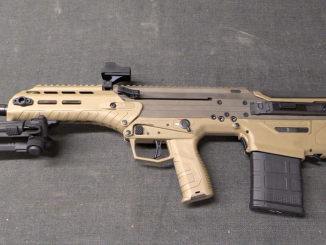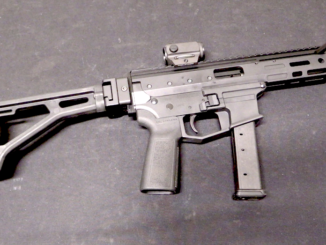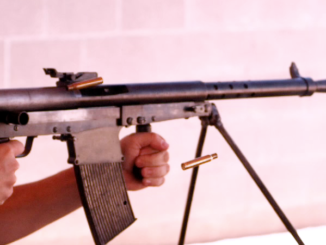Early adoption of new technology is a sword which cuts both ways – you might be getting the first of a fantastic new system, or you might be paying for a flop – and in order to get the benefit of the first possibility you must take the risk of the second. Someone buying a Luger in 1900 was making a great choice…but someone buying a Jennings repeating rifle in the early 1850s was in for disappointment.
The Jennings was one of the stepping stones to the truly successful lever action repeating rifle, but it wasn’t quite there itself. It used a type of rocket ball ammunition with the propellent loaded inside the hollow base of the bullet, thus requiring no cartridge case. It did this in conjunction with a pellet priming system, which made the Jennings a rather complicated rifle as well as being underpowered and expensive.
Even before the first full run of a thousand guns was completed, it became clear that the rifle was not going to be a commercial success. Its ammunition was rather quickly discontinued for lack of substantial sales, and this left Jennings owners (and the factory itself) in the unenviable position of having guns they could not acquire specialized ammunition for. What to do? Well, the most common solution was to convert the guns into muzzleloaders. The pellet priming system was converted to use standard percussion caps, the breech was plugged, the tube magazine under the barrel was converted to hold a ramrod, and the action parts in the receiver were removed or disabled. This may have defeated the whole point of a repeating rifle, but at least the guns could be fired this way.
The factory production even resorted to this type of conversion in order to use the stocks of parts they had manufactured when hopes were high for the system.




Slightly off topic, but when I saw “Jennings”, I immediately thought it would be video about the “awesome” Jennings Nine:
https://youtu.be/KunQNYDsNEs?t=7m58s
I suppose this Jennings is better, though, because you would be able to get at least the one shot out with fairly high confidence…:-D
“(…)able to get at least the one shot out with fairly high confidence…:-D(…)”
I wonders about somewhat inverted situation. That is you squeeze trigger and except single-shot but full-auto commence, do you know any design in which it would be possible?
Chain fire with a percussion (caplock) revolver? It has been known to happen with some designs, although it was by no means a common occurrence.
superposed load seems also to be vulnerable for such mishap:
https://en.wikipedia.org/wiki/Superposed_load
–
I forgot to add I meant more recent design, say after 1899.
“It used a type of rocket ball ammunition with the propellent loaded inside the hollow base of the bullet, thus requiring no cartridge case. It did this in conjunction with a pellet priming system, which made the Jennings a rather complicated rifle as well as being underpowered and expensive.”
I want to point, that when such solution might lead to complication of weapon, it also mean simpler ammunition (cartridge?), as it lacks case and primer. It mights look irrelevant in our times, but back then production of reliable cartridge at reasonably price, was not obvious task (cf. British .577/450 Martini–Henry in its foil iteration). I wonder about manufacturing cost of “rocket ball” for Jennings vs normal cartridge, say .44 Henry.
“(…)convert the guns into muzzleloaders. (…) This may have defeated the whole point of a repeating rifle, but at least the guns could be fired this way.(…)”
This surely lowered Rate-Of-Fire, but was probably best option from logistic point of view. It should be remembered that with invention of metallic-cartridge, earlier, percussion fire-arms did not disappear. IIRC, hand-loading of metallic cartridge, back then (in 1850s) was non-existent, so cartridges cases were disposable, hence with introduced of cases allowing to do so, they were dubbed Everlasting.
Similar example of logistic-over-performance, might be Soviet F-22:
https://en.wikipedia.org/wiki/76_mm_divisional_gun_M1936_(F-22)
which originally was meant to use proprietary ammunition, but ended using that from Pattern 1900 (Red Army possessed huge stock-pile of that ammunition produced yet during First World War), which lead to lower muzzle velocity.
F-22 were captured by Germans, some were reworked for ammunition for 7,5 cm PaK 40 /more powerful that Pattern 1900/ and became Pak 36(r).
“IIRC, hand-loading of metallic cartridge, back then (in 1850s) was non-existent”
Not entirely true. The very first “metallic” cartridges, for the Pauly breechloading break-action rifles, pistols and shotguns, were designed to be easily reloaded by the user. They were built much like a modern shotgun shell, with a rimmed brass “battery cup” head that held the primer pellet (very like the ones used by Jennings).
The paper part of the case was nitrated, and once the powder and ball were in it, it was then cemented into the brass head. When fired, everything but the head was consumed, leaving only the brass “cup” to be removed before reloading.
I might add that an analogous system with electric ignition is still used in some artillery weapons today, notably the L30 120mm CHARM rifled main gun of the British Challenger II MBT.
cheers
eon
All modern tank guns have that kind of combustible ammunition, including the Soviet/Russian & Chinese 125mm and Western 120mm guns. The last generation to use metallic cartridge cases were the Western 105mm and Soviet 115mm guns.
” The very first “metallic” cartridges, for the Pauly breechloading break-action rifles, pistols and shotguns, were designed to be easily reloaded by the user.”
Ok, I overlooked that, I should say that most popular approach to metallic cartridge at that time, was to treat it as one use only (disposable case)
I’d maintain that a Luger was an objectively bad choice even in 1900. The Colt .38 pocket was a far better semiautomatic in every way, as was the Mauser. And Colt, S&W, or Webley had revolvers that would outdo the Luger in every way. I’ve never really understood the Luger’s success outside Germany.
The problem was that each Luger pistol was a custom job with each forged part finished by a worker with craftsman’s skills. No two Luger pistols were exactly alike! And it was picky about ammunition. Unless one had the specified powder loading EXACTLY RIGHT for any given caliber, the Luger would not cycle correctly. I suppose you hadn’t looked it up, but Ian and Karl threw a refurbished (and loaded) Luger into a wheelbarrow of mud and then fired it. The Luger fired reliably and emptied the magazine. IT DID NOT JAM EVEN ONCE. The conclusion is that while the Luger is reliable if fed PROPER ammunition strong enough to cycle the action and if the insides were well maintained and kept mud free (any semi-auto will jam if mud gets in the chamber and receiver area), it is just too expensive for ordinary folks. Did I mess up?
As far as the Pocket Hammerless goes, it’s simply a matter of cartridge. The 9x19mm in the Luger far outstrips the .38 ACP in the Colt when it comes to muzzle velocity and energy. The Colt was perfectly good as an officer’s pistol, but it wasn’t really up to being a battlefield combat weapon; it could certainly never hope to provide a decent weapon for cavalry or artillerymen.
Could (contemporary) revolvers outdo the Luger? Even a top-break revolver design with a speedloader is going to be slower and more awkward to reload than the magazine-fed Luger. On that basis, and if I had to choose, I’d much rather go into a fight with a Luger than say, a Webley.
There’s no denying that the Luger was a bit sensitive to dirt and fouling, as well as being relatively expensive. On the other hand, it seems to be pleasant to shoot, and ballistically, it was superior to pretty much all of the competition. Not a bad value for 1900.
In 1900, the 9×19 was two years in the future and the pocket Colt automatic three. Your Luger would have been a .30.
“Far outstrips” the 38 ACP? There’s only a 30-50 fps velocity difference in the same bullet weights between the two. There’s that much variation in the same box of ammunition even today.
“I’ve never really understood the Luger’s success outside Germany.”
At time of its introducing (1900) it given good ballistic to mass (size) relation (or in other words it has high coefficient of metal usage that is muzzle velocity to mass of weapon ratio).
Also note that it was lighter that most “big-bore” service revolvers, but offered ballistic advantage over most “small-bore” service revolvers. Switzerland before Luger used Revolver Modell 1882 firing own cartridge with following ballistic: 7 g @ 220 m/s when 7,65×21 Parabellum – 6 g @ 365 m/s
I don’t know if better ballistics is what they were looking for in reality, though. The Austrian Rast & Gasser M1898 and its cartridge were designed well into the smokeless powder era, but had relatively modest ballistics with an 8.1 gram bullet launched at 240 m/s. My impression is that these kind of ballistics were considered sufficient for a defensive handgun by most European countries, except the UK and Germany, of course. The Italians also had the Mod. 1889 Bodeo with its 10.4mm cartridge, but they probably considered it overpowered, because in 1934 they chose the .380 ACP after a few years with the 9mm Glisenti.
The legend is that the British Army wanted large bore revolvers based on stories of ‘colonial’ conflicts where officers said they were needed to kill fanatical enemies; and that the USA got the .45 because of similar stories from the USA conquest of the Philippines.
From 1893 the German Empire was involved in a almost totally forgotten war and genocide in what was called South West Africa (modern Namibia). Could that explain Germany choosing a large caliber handgun round?
Also: does anyone have any historical primary sources for the stories that lead to large caliber handgun adoption? All I’ve ever seen is unreferenced tales in books. I wonder if it was soldiers exaggerating and newspapers needing sensation?
The British, to my knowledge, never even tried anything smaller than .45 before adopting the .38/200 in the 1930s. I suppose the theory was that making a bigger hole increases the likelyhood of damaging a vital organ or major artery, which I think is a sound theory, even if really doesn’t change the fact that shot placement remains crucial. The British Army officers and NCOs were both very professional at the time, so handling heavy recoil was less of an issue than with larger conscript armies.
I believe some documentation from the Philippines Moro rebellion does exist, which provides at least some anecdotal evidence about the ineffectiveness of the .38 Long Colt in bringing down warriors fast enough. No real scientific operational research was conducted, as far as I know. There is also no comparison data with larger bullets, so it’s impossible to say if a larger caliber handgun would have been more effective with the same shot placement.
As for the Germans, I really don’t know, but the war in South West Africa could very well have been a contributing factor. 9mm Parabellum with FMJ bullets is really somewhat of an overkill when it comes to handguns, because it tends to overpenetrate. Not that overpenetration is necessarily a bad thing in military context, but higher bullet momentum means heavier recoil for the shooter. That was particularly important considering everyone shot handguns with one hand at the time. Possibly they wanted extra penetration to account for thick winter clothing, French cuirassier armor and the like.
What is clear, though, but often not understood is that post-WW2 NATO adoption of 9mm Parabellum as the standard handgun cartridge had very little to do with handguns or their performance, but a lot to do with SMGs. The British and Italians adopted 9mm Parabellum as the SMG cartridge during WW2 and the French did so after the war, because 7.65mm Long had been found out insufficient for that role. Adoption of 9mm semiauto pistols then followed as a consequence. The West Germans had no real power in the early NATO, but were of course happy to use the same cartridge they had used already since 1908.
“Also: does anyone have any historical primary sources for the stories that lead to large caliber handgun adoption? All I’ve ever seen is unreferenced tales in books. I wonder if it was soldiers exaggerating and newspapers needing sensation?”
Query .38 Long Colt in Wikipedia:
https://en.wikipedia.org/wiki/.38_Long_Colt#History_and_usage
has quote from Col. Louis A. LaGarde which given name, places and date, so it looks quite true for me – maybe someone having more knowledge about 1910s in military history of United States would write more.
“I suppose the theory was that making a bigger hole increases the likelyhood of damaging a vital organ or major artery, which I think is a sound theory, even if really doesn’t change the fact that shot placement remains crucial.”
I want to note that all British “.45” caliber were backward compatible with older, so:
.455 Webley revolves might fire .476 Enfield cartridge
.476 Enfield revolvers might fire .450 Boxer Mk I cartridge
Such ability mights look as a curiosity, but in 1900s, British Empire was big and vast, so I presume, not every place allowed easy delivery, so having ability to load revolver with older ammunition might become useful.
“What is clear, though, but often not understood is that post-WW2 NATO adoption of 9mm Parabellum as the standard handgun cartridge had very little to do with handguns or their performance, but a lot to do with SMGs.”
When 9×19 Parabellum formally become 9×19 NATO?
9×19mm was officially adopted by NATO in 1962, I believe. 9mm NATO specification (STANAG 4090) is actually an overpressure variant of the traditional 9mm Parabellum, +P by SAAMI nomenclature and illegal for civilian sales in CIP countries. It seems likely that this choice was done to facilitate “hot” SMG loads already in service, although I don’t have any certain information about that.
Not all countries decided to load their ammunition to the maximum pressure; for example West Germany continued to use roughly the same specs as before the war so that they could continue to use the P38/P1. Possible wartime use of hotter ammunition from another NATO country in pistols was probably not considered a huge deal for obvious reasons.
“I don’t know if better ballistics is what they were looking for in reality, though.”
Indeed Switzerland produced Revolver Modell 1882 in its improved version (1882/29) until 1946.
Thank you for all your replies. I am regularly astounded by the level of cooperative understanding displayed on here.
Just to add to what Euroweasel has written about 9mm Parabellum. An Ian Van Hogg book I owned in the late 70’s explained that the British Sten was chambered for 9mm (nominally .38) because of the capture of many hundreds of thousands of rounds from the Italians in the East African (Abyssinian) campaign.
So Britain built a gun to fit all those free rounds. I do not know if she then manufacture 9mm Parabellum afterwards. but even if she didn’t there would have been millions of the round left after tWWII and little reason to adopt anything else.
” I do not know if she then manufacture 9mm Parabellum afterwards”
Yes, page about 9×19 mm in Great Britain:
https://sites.google.com/site/britmilammo/9mm-parabellum
after scrolling down, you will have 6 links to subpages.